 |
SUMMARY SESSIONS
14 November 2002
9h00 >10h30
INAUGURATION
| 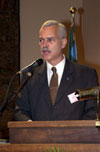 |
 |
World Heritage 2002: Shared Legacy,
Common Responsibility, the International Congress on the occasion
of the 30th anniversary of the World Heritage Convention was opened
on November 14th at the Cini Foundation in Venice by Marcio Barbosa,
Deputy Director-General of UNESCO.
In his speech, the Deputy Director-General of UNESCO reminded participants that the United Nations General Assembly
proclaimed 2002 as the United Nations Year for Cultural Heritage,
which he called, "a valuable opportunity for UNESCO to deepen
and extend international cooperation in the field of heritage protection
and the promotion of cultural diversity."
Speech available
in PDF
|
Next, Nicola Bono, Italy's Undersecretary
for Culture, took the podium and spoke about "Cultural Tourism partnerships."
He stressed the importance of sharing Italy's experience in heritage identification,
protection and promotion, and in particular a new Italian law which supports
local tourist systems by promoting economic development and attracting investments
for cultural tourism projects, especially those which are linked with regional
cuisine, arts and crafts.
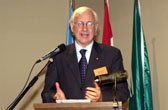 |
 |
Paolo
Costa, Mayor of Venice, addressed the Congress with the dichotomy
that, "It is a privilege but it is also a our duty to safeguard
our cultural heritage." His speech emphasized that, "protecting
our cultural heritage is protecting our identity."
|
| Luigino Busatto,
President of Province of Venice, proclaimed that "our focus should
be on schools and young people." He pointed out that current
curriculums are focused too much on the future. "We need to increase
the focus on history and raise awareness of heritage values,"
he added. Busatto expressed his hope that the results of the Congress
"will lead to new programs for young people, the citizens of
tomorrow." Speech available
in PDF |
 |

|
10h30 >11h30
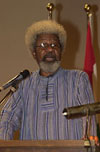 |
 |
UNESCO
Goodwill Ambassador Wole Soyinka
delivered an impassioned keynote address which many participants heralded
as "justifying the trip to Venice in itself". He asked participants
if anyone can forget the Taliban and the destruction wrought upon
the Buddhas of the Bamiyan Valley. "We tend to forget that this
same type of threat is ever present," cautioned Soyinka. Giving
examples of the clash between religious cultures in his homeland,
Soyinka spoke of the destruction of Ibu homes in Nigeria as a "death
sentence on traditional heritage" and how such destruction is
becoming not only an environmental but a "cultural cleansing."
Citing further examples of "Religious Storm Troopers" destroying
cultural treasures in Cambodia, Yugoslavia and the Middle East, Soyinka
concluded that, "there is a lesson in all of this that we must
learn: Crimes against humanity tend to go hand in hand with the destruction
of the victim's culture." He ended his address by asking participants
to: "Think of what we may have lost in illumination." Speech available
in PDF
|
| In the second keynote address, Tamàs
Fejérdy, Chairperson of the World Heritage Committee,
presented the June 2002 Budapest Declaration on World Heritage, which
he said "provides the strategic framework for existing and new
World Heritage partnerships at the present time and in the future."
Specifically, strengthening the Credibility of the List, ensuring
effective Conservation, promoting Capacity-building, and increasing
public awareness, involvement and support through Communication. In
"updating its strategic outlook," Fejerdy said that the
Committee, "has given its commitment and expressed its will to
cooperate and seek the assistance of all partners for the support
of World Heritage." Speech available
in PDF |
 |

|
11h30 >13h00
|
INTERNATIONAL COOPERATION
FOR WORLD HERITAGE CONSERVATION |
|
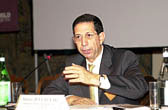 |
 |
Mounir
Bouchenaki, UNESCO Assistant Director-General for Culture,
opened the second session on International Cooperation for World Heritage
Conservation by pointing out that "Venice is the perfect place
to hold this discussion because the city was preserved through international
partnerships." Bouchenaki praised the Italian Government for
its role in promoting cultural heritage and specifically the voluntary
contribution it has made to UNESCO ($2.4 million), which helps to
safeguard the heritage of other countries including the Stone Town
of Zanzibar and the Medina of Fez. |
Director General of the Cultural Promotion and
Co-operation Directorate (DGPC) of the Ministry of Foreign Affairs
(MAE), Francesco Aloisi de Larderel,
reiterated that the protection of cultural heritage is an important
component of Italian International Policy, and includes the belief
that, "A better understanding of our common World Heritage should
lead to a better respect of different cultures." He also suggested
that the 1972 Convention provides a model for another kind of heritage
protection. "Some of what we've learned in the past 30 years
of protecting World Heritage can be incorporated into drafting a convention
on intangible heritage," said Larderel.
|
 |

|
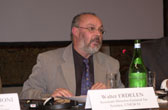 |
 |
Walter
Erdelen, UNESCO Assistant Director-General for Science, who
co-chaired the session with Bouchenaki, stressed the importance of
moving the focus of International Cooperation from individual sites
to networks of sites and developing links between protected areas,
such as seascapes and landscapes. He also inform the meeting that
the Chairpersons of the Man and the Biosphere (MAB) Programme and
the World Heritage Committee would meet to reinforce the link between
World Heritage and MAB programmes. |
| "The existing heritage delivery system is
inadequate," said Christina Cameron,
Director General, National Historic Sties Directorate, Parks Canada,
"it needs to reposition itself in the international community."
One way she suggests is through "altruistic marketing" such
as publishing the In Danger List along with the costs of rehabilitation
and conservation. "What would it take to convince you to choose
to invest in World Heritage?" asked Cameron. "It contributes
to the economy through regional development and tourism revenues,
to biodiversity protection, to scientific research as natural laboratories,
and they serve as unique instruments of peace as storehouses of memory
for our world's natural and cultural heritage." |
 |
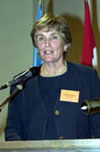
|
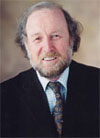 |
 |
Francesco
Francioni, Chair of International Law and Vice Rector of the
University of Siena, discussed the impact the World
Heritage Convention has had on international law, notably in bringing
about a holistic approach to culture and nature. He noted that the
Convention anticipated the tremendous development of international
environmental law seen in the past two decades. Today, he said: "A
common concern of humankind has emerged with regard to biodiversity
and climate change that requires preventive action, both in treaty
law and in soft law." Francioni called for "a contextual
interpretation" of the Convention in modern terms, noting: "For
example, in 1972 non-renewable resources were defined as things like
mineral wealth, but today we have realised that living resources are
exhaustible, like fish and water resources." He said there was
an "overarching principle" of cooperation between states,
which "is especially important in preventing dispersion and loss,
which is today a big problem because of theft, looting, illicit trade
in cultural property, and so on. … The duty to cooperate is really
an obligation today. The State Party should not see that as merely
an option."
|
 |
14h30 >16h00
|
ENLARGING THE CIRCLE
OF PARTNERS |
|
The fourth session of the Congress
addressed Enlarging the Circle of Partners and was chaired by José
Maria Ballester, Director Culture, Cultural and Natural Heritage,
Council of Europe. Using many case studies from historic cities, one
of the largest thematic categories of World Heritage, the session
focused on how partnerships can foster social and economic development.
Defining collaborations between the Council of Europe and the World
Heritage Centre as "always complementary," Ballester pointed
out that it's a shared effort to enlarge the circle of partners. "On
local, regional, national and international plans, the multiplicity
of competence is becoming more and more important," he added.
"What is the best way to protect heritage?, Why? And for whom?,"
asked Ballester. "This is a moment when we need to work together
for conflict prevention by increasing our intercultural and inter-religious
knowledge in order to promote cultural diversity," he answered.
"Now cultural heritage can be a vector for economic development,
especially in fragile societies."
|
 |

|
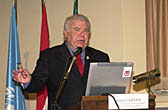 |
 |
Jaime
Lerner, Governor of the State of Paraná in Brazil took
a philosophical approach to partnerships, which was based on his long
experience of both developing and implementing conservation policies
for cities. "Enhancing heritage is a learning process,"
he said, "Learning to understand the problem is the key to preservation."
Lerner told participants that thinking of cities as solidarity's last
refuge is the best hope for their preservation. "It is possible
to make positive changes in every city in the world in less than two
years," claimed Lerner, "but we have to have political will,
strategy and solidarity. It's not so much a question of funds as a
question of co-responsibility." |
Franco Passacantando,
Dean of the Executive Board of The World Bank, explained the World
Bank's action in cultural heritage as falling under two categories:
1) safeguarding policies, such as for prevention of damage to cultural
sites; and 2) lending policies for cultural heritage, such as redevelopment
of historical sites in rural areas, providing support to governments
and private institutions. "The program is small but not insignificant,"
said Passacantando.
Possibilities for future partnerships depend upon finding a balance
between conservation and development; measuring economic and social
returns; and both partners willing to compromise to reach results.
|
 |
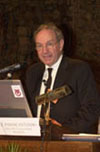
|
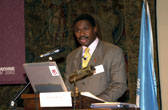 |
 |
Jean Bakole
from United Nations Habitat delivered a speech on behalf of Executive
Director Anna Kajumolo Tibaijuka, emphasizing the necessity of converging
environmental and social approaches to conservation efforts. He urged
that the politics of social housing be present in cultural heritage
protection plans for cities. |
| Yves Dauge,
Member of the French Senate for the region of Indre & Loire and
Mayor of the City of Chinon, animated the discussion by extolling
the virtues of networking and decentralization. "We need to increase
the engagement of States Parties," said Dauge, "but they
need to be democratised so that we increase the involvement of regions
and cities." Dauge pointed out that laws evolve with time, and
often improve. "We need to evaluate the ways we implement laws,"
said Dauge. He recommended that each State Party to the World Heritage
Convention evaluate the laws they have in place to protect the natural
and cultural heritage in their own countries, and then share their
knowledge and expertise with other countries. |
 |

|
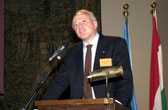 |
 |
A question and answer session
followed the discussion, in which Francesco
Bandarin, Director, UNESCO World Heritage Centre, asked Passacantando
why in spite of the expressed commitment, the World Bank collaboration
with UNESCO had not taken off. Passcantando answered that this was
due to misconceptions that many shareholders have about World Heritage,
but hoped that his speech would change their perspective. He suggested
that the organisations should start with informal partnerships before
launching formal ones. "A bottom-up approach could lead to more
formal partnerships," said Passacantando.
|
16h30>18h30
|
LINKING
WORLD HERITAGE CONSERVATION AND SOCIAL AND ECONOMIC DEVELOPMENT
|
|
Panel chaired by Achim Steiner, Director-General
of IUCN - World Conservation Union
The
Mayor of Venice, Paolo Costa,
opened the session with a discussion of his city's longstanding and
complex relationship with tourists, who visit at a rate of 12 million
per year. Given the unique geography of the city, it can just accommodate
some 40,000 visitors a day, but "if it goes beyond that it becomes
almost unbearable," Costa said, adding the warning: "Since
it is so successful, tourism is shutting out other activities."
If it became the only activity, he said, "that would be destroying
the magic of Venice."
Speech available
in PDF
Frances Cairncross,
Management Editor of The Economist magazine and author of "Costing
the Earth" and "Green Inc.", posed the question of assigning
an economic value to heritage and culture. "It's hardest of all to
value a beautiful view," she said. Cairncross suggested that the best
solution to the tourism boom may be to "ration our heritage" by
"using market forces to help rather than damage our beauty."
Corrado Clini,
Director General of Italy's Ministry for the Environment, discussed ways
in which partnerships between companies and environmental agencies can improve
the quality of tourist destinations at the same time as they boost the economy,
notably when they are guided by appropriate laws, best practices and voluntary
agreements.
The search for equitable ways to distribute the benefits of tourism was
the topic of Rili Hawari Djohani
of Indonesia, the world's largest archipelago. Noting that half the world's
population lives in coastal areas, she said that while the main reason
for establishing marine World Heritage sites is to protect biodiversity,
it is often difficult to explain their importance to local fishermen.
Djohani, Director of the Nature Conservancy Coastal and Marine Indonesia
Programme, described efforts to generate alternative economic benefits
for displaced local communities.
Lota Melamari,
the former Director General of Tanzania National Parks, focused on strengthening
the role of the community in the management of heritage sites. A positive
example is Tanzania's Serengeti National Park, he said. Melamari also lamented
the relative underdevelopment of African heritage, with only 53 World Heritage
sites inscribed so far. In a similar vein, Dawson
Munjeri of Zimbabwe, a cultural heritage management
expert, said that despite expectations that the idea of cultural landscapes
would improve the regional balance of the World Heritage List, most cultural
landscapes so far inscribed are in Europe, which has the most overall sites
as well.
Finally, Eugenio Yunis,
Head of Sustainable Development of Tourism at the World Tourism Organisation,
discussed the need for the "wise management" of tourism flows.
Heritage has value by being used, he noted, "but only if it is used
in a reasonable and sustainable manner." He proposed the designation
of ever larger areas - even entire regions -- for World Heritage protection.
 |
Back
|
 |






